I'm subscribed to a lot of blogs. I like to read about what people are working on, what their ideas are, and feel like I'm simply lurking through the electronic pages of a gaming library. I don't often comment, but I do bookmark. Here are a few links that I think would be invaluable to a lot of gamers.
The Three Opposed Faction Favour Tracker seems like the ideal tool for tracking rival groups in a city-based campaign. If the PCs gain favour with one faction they'll risk alienating the others. It's possible to be in good with two factions at the risk of completely ruining your relationship with the third.
A friend shared this link on facebook and I thought the visual image of the contents from a modern day archaeologist's backpack was too good not to bookmark as a guide for making up equipment lists, as both a player and a GM.
This custom rule for chase scenes uses a deck of cards and is so awesome I've thought about opening sessions with a chase. The author even has a follow-up post covering variations if you want to mix things up a little more. Good stuff!
This List of Medieval and Fantasy Background Sound and Noise is really awesome. I had no idea sound mixers like these existed on the internet. Even if you don't use them they're worth a listen!
This is the most recent post I've bookmarked, and the inspiration for sharing the awesome. Megadungeon Practices is not only a good checklist for how to start constructing a megadungeon, but it could easily be modified for creating a densely populated city, society, or region. Just apply the advice to a different expanse of geography!
Friday, May 30, 2014
Thursday, May 29, 2014
diphikulte
I read the rules for Numenera a couple of months ago and I couldn't quite put my finger on why it didn't resonate with me, until today. I was reading the rules for mutants & machineguns (m&m) and about the only thing it has in common with Numenera is that difficulties are determined on a scale. In m&m this is fairly simple since doing stuff requires a roll of 2d6, there are five levels of difficulty and a trivial level called "routine" is mixed in there so it's more like it only has four difficulty levels. Numenera has ten difficulty levels and most of the game mechanics involve jumping up and down the scale of difficulty, on top of that your ability to change difficulty levels increases as you level up. As a GM it's a little difficult to call a difference between a "challenging" or "formidable" difficulty, so it almost feels like the target numbers for tasks should just increase as PCs level up - which feels disingenuously like d20 mechanics. d20 has this tendency of making everything across the board increase in difficulty in relation to what level the PCs are, which means tasks are almost always hovering around this 50% chance of success for everything and if your chances of succeeding are always relatively the same then what's the point of leveling up?
Numenera is a really awesome setting! I feel like I should point that out right now since all I'm ever going to do is bitch about the game's mechanics. I hate the rules, I don't find them intuitive to use at all. But the setting, the history, the technology, and the peoples and creatures are all great. As I read further into the rulebook I really enjoyed immersing myself in this strange new world and I really wanted to try playing it. The rules just get in my way. I've thought about matching the setting to something else, like World of Darkness or Stars Without Number or Dungeon World or something, but it seems like a lot of work to do for something I might only play for a couple of sessions before everyone involved wants to play something else.
But here's a thing about difficulty levels that I think is stupid: there is always some level for "routine" tasks. Not just in m&m but also in Numenera and in 3rd edition D&D and in Deadlands and in Shadowrun. Shit! Just about any RPG that uses levels of difficulty has a trivial or routine level. What's the point? Nobody is ever going to roll for a routine task, and if they do it's going to be incredibly lame when you ask them to roll the dice to brush their teeth and they roll a 1 because now you have to come up with some reason for why they failed at brushing their teeth. I guess in Numenera's case it is there to illustrate how low you can reduce the difficulty of a task before it becomes practically a routine task, but if the game doesn't allow for adjustable difficulty then there's almost no reason for it to be in there.
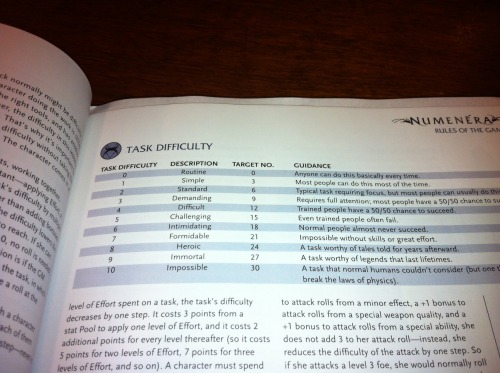
Numenera is a really awesome setting! I feel like I should point that out right now since all I'm ever going to do is bitch about the game's mechanics. I hate the rules, I don't find them intuitive to use at all. But the setting, the history, the technology, and the peoples and creatures are all great. As I read further into the rulebook I really enjoyed immersing myself in this strange new world and I really wanted to try playing it. The rules just get in my way. I've thought about matching the setting to something else, like World of Darkness or Stars Without Number or Dungeon World or something, but it seems like a lot of work to do for something I might only play for a couple of sessions before everyone involved wants to play something else.
But here's a thing about difficulty levels that I think is stupid: there is always some level for "routine" tasks. Not just in m&m but also in Numenera and in 3rd edition D&D and in Deadlands and in Shadowrun. Shit! Just about any RPG that uses levels of difficulty has a trivial or routine level. What's the point? Nobody is ever going to roll for a routine task, and if they do it's going to be incredibly lame when you ask them to roll the dice to brush their teeth and they roll a 1 because now you have to come up with some reason for why they failed at brushing their teeth. I guess in Numenera's case it is there to illustrate how low you can reduce the difficulty of a task before it becomes practically a routine task, but if the game doesn't allow for adjustable difficulty then there's almost no reason for it to be in there.

Wednesday, May 28, 2014
Lair of the Unknown, by Johnstone Metzger
This adventure module is reminiscent in both title and story of an early Dungeons & Dragons module, In Search of the Unknown. Like his previous module, Metzger lays out this adventure as a collection of resources for setting up the adventure and allowing the players to set their own pace. The environment in town is charged and ready for conflict with plenty of NPCs, and the dungeon itself is large and features a broad variety of challenges. However, unlike the previous one I reviewed it is only meant to be used with Dungeon World rules, though it would not be difficult to convert it to Labyrinth Lord. This is another first in a trilogy which are given traditional module code numbers, Lair of the Unknown is given the code DW1 which probably stands for Dungeon World. I own the original D&D adventure that Johnstone Metzger is name-dropping and I will try to both avoid making direct comparisons or pointing out obvious similarities.
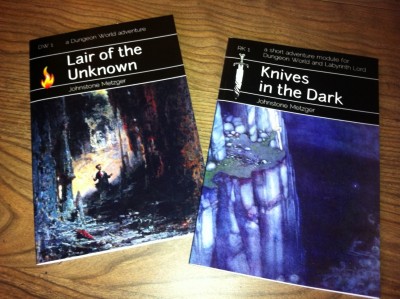 Lair of the Unknown is set up as an introductory adventure for a beginning group of characters, and the first 18 pages could have been a very useful resource all by itself for creating a campaign and pushing the PCs into the direction of adventure. The next parts of the book describe some of the challenges that could crop up both in town and in the nearby dungeon, and these are structured as individual pieces that can easily be dropped into the story or left out entirely. The sandbox nature of the town of Westham puts a burden onto the players to find their own way, but there are plenty of obnoxious NPCs that could make trouble in the PCs lives if they stay in town for too long.
Lair of the Unknown is set up as an introductory adventure for a beginning group of characters, and the first 18 pages could have been a very useful resource all by itself for creating a campaign and pushing the PCs into the direction of adventure. The next parts of the book describe some of the challenges that could crop up both in town and in the nearby dungeon, and these are structured as individual pieces that can easily be dropped into the story or left out entirely. The sandbox nature of the town of Westham puts a burden onto the players to find their own way, but there are plenty of obnoxious NPCs that could make trouble in the PCs lives if they stay in town for too long.
The second half of the book is dedicated to the lair, named Xallevyrx, and it is filled with numerous dangers and threats that would be unique challenges even for seasoned adventurers to overcome. However, the layout of the maps is disorienting and only by reading room descriptions can you understand where they link up, preparation is definitely required to familiarize one's self with the dungeon since several areas of Xallevyrx lead directly to an underground cave system which could act as an alternate entrance or escape route, but the maps themselves are of no help whatsoever. This may be the only thing I found confusing and really didn't like about the module.
The final section of the book details some custom rules and compendium classes to introduce to your campaign, one of which is a full-fledged class dedicated to exploring underground lairs: the Dungeoneer! When I first purchased the module this class was the first thing I read and I made my own custom character sheet for it, though you can also find the details for it, and a series of other classes Johnstone Metzger has written, in a pay-what-you-want collection on DriveThruRPG.
The book really shines in the early chapters, where it is filled with excellent advice and interesting details, but there's a section titled 'They Who Make Trouble' which seems tacked on to the adventure to make it more than just a dungeon. The dungeon itself feels a bit dry and flat, even when I try to ignore the obvious inspirations for it. The most interesting part of the adventure is in the deepest and darkest part of the dungeon, which it is noted that even the author's players never managed to explore. The new Dungeoneer class is also a real piece of quality work and I really like it, but it may seem overwhelming to a beginning player, and it is probably only going to be useful if your campaign focuses solely on exploring dungeons and caves.
You can purchase both pdf and print versions of "DW1 - Lair of the Unknown" at DriveThruRPG or just a print version at Lulu
 Lair of the Unknown is set up as an introductory adventure for a beginning group of characters, and the first 18 pages could have been a very useful resource all by itself for creating a campaign and pushing the PCs into the direction of adventure. The next parts of the book describe some of the challenges that could crop up both in town and in the nearby dungeon, and these are structured as individual pieces that can easily be dropped into the story or left out entirely. The sandbox nature of the town of Westham puts a burden onto the players to find their own way, but there are plenty of obnoxious NPCs that could make trouble in the PCs lives if they stay in town for too long.
Lair of the Unknown is set up as an introductory adventure for a beginning group of characters, and the first 18 pages could have been a very useful resource all by itself for creating a campaign and pushing the PCs into the direction of adventure. The next parts of the book describe some of the challenges that could crop up both in town and in the nearby dungeon, and these are structured as individual pieces that can easily be dropped into the story or left out entirely. The sandbox nature of the town of Westham puts a burden onto the players to find their own way, but there are plenty of obnoxious NPCs that could make trouble in the PCs lives if they stay in town for too long. The second half of the book is dedicated to the lair, named Xallevyrx, and it is filled with numerous dangers and threats that would be unique challenges even for seasoned adventurers to overcome. However, the layout of the maps is disorienting and only by reading room descriptions can you understand where they link up, preparation is definitely required to familiarize one's self with the dungeon since several areas of Xallevyrx lead directly to an underground cave system which could act as an alternate entrance or escape route, but the maps themselves are of no help whatsoever. This may be the only thing I found confusing and really didn't like about the module.
The final section of the book details some custom rules and compendium classes to introduce to your campaign, one of which is a full-fledged class dedicated to exploring underground lairs: the Dungeoneer! When I first purchased the module this class was the first thing I read and I made my own custom character sheet for it, though you can also find the details for it, and a series of other classes Johnstone Metzger has written, in a pay-what-you-want collection on DriveThruRPG.
The book really shines in the early chapters, where it is filled with excellent advice and interesting details, but there's a section titled 'They Who Make Trouble' which seems tacked on to the adventure to make it more than just a dungeon. The dungeon itself feels a bit dry and flat, even when I try to ignore the obvious inspirations for it. The most interesting part of the adventure is in the deepest and darkest part of the dungeon, which it is noted that even the author's players never managed to explore. The new Dungeoneer class is also a real piece of quality work and I really like it, but it may seem overwhelming to a beginning player, and it is probably only going to be useful if your campaign focuses solely on exploring dungeons and caves.
You can purchase both pdf and print versions of "DW1 - Lair of the Unknown" at DriveThruRPG or just a print version at Lulu
Tuesday, May 27, 2014
Knives in the Dark, by Johnstone Metzger
I have a soft spot in my heart for anything that Johnstone Metzger writes, solely because he endeared himself to my sensibilities when I discovered his Heralds of Hell playbooks for Apocalypse World, but also because he can write some damn cool gaming resources and essays (venture down his blog's archives). A short time ago he began writing adventure modules that were dual-stated for both Dungeon World and Labyrinth Lord and so far he has produced six titles, I bought the first two but never got around to reading them until recently.
 Knives in the Dark is a creepy horror adventure about undead assassins who have been released from their secret tomb. The town of Affeldeen and the mountain range in which it is nestled, the Black Peaks, serves as the adventure setting. Some dimwitted tin miners act as the catalyst that gets the adventure started, and provide most of the dramatic points for furthering the story.
Knives in the Dark is a creepy horror adventure about undead assassins who have been released from their secret tomb. The town of Affeldeen and the mountain range in which it is nestled, the Black Peaks, serves as the adventure setting. Some dimwitted tin miners act as the catalyst that gets the adventure started, and provide most of the dramatic points for furthering the story.
Instead of a traditional adventure module structure, the booklet acts as a collection of resources for setting up the adventure and letting the players look under the blanket of the story and the setting at their own pace. The social environment around the mining camp and the town is filled with NPCs, about half of which only get a sentence or two but are varied enough that any collection of adventurers should be able to find something to do. The mountain where the shadowy terrors have awakened gets it's own chapter and there is a modest dungeon with plenty of unique challenges laid out within. The book is filled with a plethora of custom moves uniquely wrapped around the environment and the story.
The most interesting and useful part of the adventure are the details surrounding the goals of both the assassins and the Governor, they are explicit enough to give a good direction for why and how the story should unfold but leave all of the intricate details of when the plot opens up in the hands of the GM. There is no railroading here, and the centerpiece villain of the adventure (a dragon made of shadow) might not even show up if the PCs are really efficient at finding and stopping the shadow assassins - though that outcome is as unprofitable as it is unexciting.
This adventure is the first of a trilogy which are given traditional module codes, Knives in the Dark is given the code RK1 which I believe stands for River Knife though nothing in the module explicitly states that. You can purchase both pdf and print versions of "RK1 - Knives in the Dark" at DriveThruRPG or just a print version at Lulu
 Knives in the Dark is a creepy horror adventure about undead assassins who have been released from their secret tomb. The town of Affeldeen and the mountain range in which it is nestled, the Black Peaks, serves as the adventure setting. Some dimwitted tin miners act as the catalyst that gets the adventure started, and provide most of the dramatic points for furthering the story.
Knives in the Dark is a creepy horror adventure about undead assassins who have been released from their secret tomb. The town of Affeldeen and the mountain range in which it is nestled, the Black Peaks, serves as the adventure setting. Some dimwitted tin miners act as the catalyst that gets the adventure started, and provide most of the dramatic points for furthering the story. Instead of a traditional adventure module structure, the booklet acts as a collection of resources for setting up the adventure and letting the players look under the blanket of the story and the setting at their own pace. The social environment around the mining camp and the town is filled with NPCs, about half of which only get a sentence or two but are varied enough that any collection of adventurers should be able to find something to do. The mountain where the shadowy terrors have awakened gets it's own chapter and there is a modest dungeon with plenty of unique challenges laid out within. The book is filled with a plethora of custom moves uniquely wrapped around the environment and the story.
The most interesting and useful part of the adventure are the details surrounding the goals of both the assassins and the Governor, they are explicit enough to give a good direction for why and how the story should unfold but leave all of the intricate details of when the plot opens up in the hands of the GM. There is no railroading here, and the centerpiece villain of the adventure (a dragon made of shadow) might not even show up if the PCs are really efficient at finding and stopping the shadow assassins - though that outcome is as unprofitable as it is unexciting.
This adventure is the first of a trilogy which are given traditional module codes, Knives in the Dark is given the code RK1 which I believe stands for River Knife though nothing in the module explicitly states that. You can purchase both pdf and print versions of "RK1 - Knives in the Dark" at DriveThruRPG or just a print version at Lulu
Monday, May 26, 2014
Grand Theft Auto

Grand Theft Auto III
At the beginning of Grand Theft Auto III (GTA3) you are asked by a fellow escaped prison inmate, his name is Eight-Ball, to take him to a safehouse he knows about. His hands are broken and burned, he can't drive so you must do it for him. Arriving at the safehouse you and Eight-Ball get a change of clothes and he asks you to take him to his old boss'es nightclub. It's your first mission in the game and it's relatively simple. Drive to point A, then drive to point B. When the mission is over there is a character who tells you to go around to the back of the nightclub where your next mission awaits, but there is nothing stopping you from getting back into your stolen car and driving off into the city and never coming back.
When I first played GTA3 I completed the first few missions for Luigi, the mafia nightclub owner who gives you the first simple missions and sets up your other contacts, and then his missions ran out and I got lost. It's hard for me to imagine now, but I couldn't find my way in the city blocks around his nightclub. I drove down a street that looked familiar and then found the elevated train that led back to the front of my safehouse alley. As I pulled my car into that alley I was annoyed and thinking "What kind of game is this? It's not telling me where to go and what to do."
That was the moment where I realized what that actually meant, and it was a revelation!
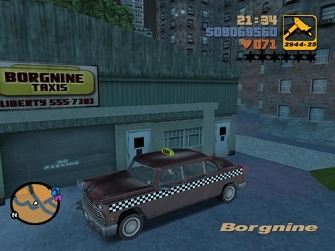 Can I just run down pedestrians on the street? Yes. Can I blow up this car? Yes. Can I jump my car off this cliff? Yes. Can I drive on the train tracks? Yes. Can I just stand on this street corner and listen to the pedestrians? Yes. Can I steal this Taxi? Yes. Can I pick pedestrians up and take them to their destinations? YES! This was the kind of video game I had always wanted, it gave the player what most games only cheat at giving: freedom.
Can I just run down pedestrians on the street? Yes. Can I blow up this car? Yes. Can I jump my car off this cliff? Yes. Can I drive on the train tracks? Yes. Can I just stand on this street corner and listen to the pedestrians? Yes. Can I steal this Taxi? Yes. Can I pick pedestrians up and take them to their destinations? YES! This was the kind of video game I had always wanted, it gave the player what most games only cheat at giving: freedom. The story in GTA3 is virtually nonexistent, and consists of taking a series of jobs from psychopaths and criminals, whose allegiances pit the player against former allies throughout the course of the game. This isn't where the game shined, instead it was in the world and the freedom of testing what would happen by interacting with it, usually violently. The more I played, the more I explored the limits of what the game was capable of, and the longer I stayed in this world the more I became acutely aware of the game world's limitations. In truth, it really doesn't give you complete freedom, but it gave enough of illusion of freedom that testing the limits of what could be done within the game seemed like it would never run out. The boundaries of the world can only stretch so far, and the game could only give so much. The talk radio station, Chatterbox, featured a roughly hour-long loop of dialogue that breathed life into the setting, but it only left me craving more.
Grand Theft Auto: Vice City
Grand Theft Auto: Vice City was the first video game I ever pre-ordered. I remember checking the preview website every week, waiting for a new screenshot or a new update from the fictional Kent Paul. When the game neared release I checked it every day. I re-started GTA3 and finished it to 100% completion twice in the time I waited, so great was my anticipation.
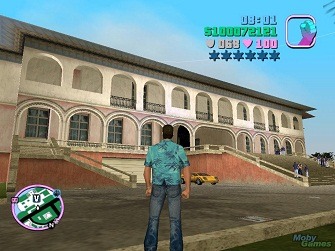 Delving into the 1980s Miami-inspired Vice City, a deeper story was told and a broader picture of this world emerged, despite the fact that the only things linking this game to the previous one were a few weak references to Liberty City and the appearance (but not the voice) of Donald Love, a major character from GTA3. The main character of Vice City (I would be remiss if I referred to him as a protagonist) was given a voice and the story was told from his perspective, this could give context and narration for the more ambiguous missions.
Delving into the 1980s Miami-inspired Vice City, a deeper story was told and a broader picture of this world emerged, despite the fact that the only things linking this game to the previous one were a few weak references to Liberty City and the appearance (but not the voice) of Donald Love, a major character from GTA3. The main character of Vice City (I would be remiss if I referred to him as a protagonist) was given a voice and the story was told from his perspective, this could give context and narration for the more ambiguous missions. Serving as a prequel of sorts for GTA3, Vice City put the player into the shoes of Tommy Vercetti, an old-fashioned mobster put in charge of a drug deal turned bad. Vercetti's first goal is to get revenge for the game's opening betrayal, and when I first encountered the mission that sent me after the top criminal of Vice City I thought "I'm at the ending already?" The game seemed short, but the story continued on after I had defeated Ricardo Diaz. The revelation of this game was discovering that I was taking over the criminal empire and could now purchase property and run businesses in Vice City. My mind boggled! Discovering the businesses and unlocking the profits from them was more exciting than playing through the story.
This game wasn't just about revenge, it wasn't just telling the story of Tommy Vercetti, it was built around the idea that the player could build and run a criminal empire. This is the charm of what the game really held, but you don't discover this until you're halfway through the story. It was a one-two punch for anybody expecting just more of the same GTA.
Manhunt
I can't talk about GTA without mentioning Manhunt, it's an ultra-violent stealth-based video game where you play the role of James Earl Cash, a convicted murderer who has been secretly kidnapped from his execution to "star" in a snuff film where he has to sneak past various gangs that are all getting paid to hunt him down through a dilapidated section of the fictional stand-in for Philadelphia known as Carcer City.
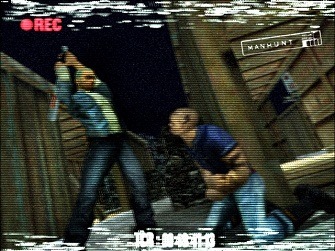 Anybody who has played Manhunt alongside any of the GTA games will instantly see the links connecting the two. Every iteration of GTA makes references to Carcer City, and many of the fictional brand names that were created for Manhunt have carried over to the GTA games in different ways. There is a literal connection on one of the radio stations of GTA3 as an announcer broadcasts a news story about the events of Manhunt, placing the game in the GTA timeline as a prequel to GTA3.
Anybody who has played Manhunt alongside any of the GTA games will instantly see the links connecting the two. Every iteration of GTA makes references to Carcer City, and many of the fictional brand names that were created for Manhunt have carried over to the GTA games in different ways. There is a literal connection on one of the radio stations of GTA3 as an announcer broadcasts a news story about the events of Manhunt, placing the game in the GTA timeline as a prequel to GTA3.This game, rather than being a world to explore, is challenging and tense. It was a punch to the gut for anybody expecting more of the bawdy and twisted humor from GTA to find a seedy and profane world of criminals and deviants. GTA is a punchline about atrocity, Manhunt is the cold rebuttal. Despite the fact that Manhunt is not officially part of the GTA universe, it's the best game in the series!
Grand Theft Auto: San Andreas
The opening of Grand Theft Auto: San Andreas sees our new protagonist, Carl Johnson, getting pulled over and harassed by two dirty cops. The entire game is four times bigger and three times longer than anything that has come before in the GTA series, but Carl spends most of his time getting kicked down and pushed around by all of the people in his life. This was the first game that featured a traditional story arc and feature five distinct acts coordinated with the location of missions within the terrain of the west coast state, San Andreas - which actually acts as a hybrid of southern California and Nevada.
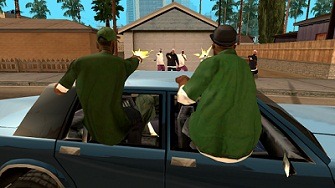 In the first act we see Carl rejoining his old boyhood gang, the Grove Street Families, and trying to rebuild their influence and control over east Los Santos, the game's parody of Los Angeles. At the end of the first act Carl is betrayed, and those two dirty cops from the beginning force Carl to start working for them, all in the name of keeping his brother safe while he's stuck in prison. During this second act Carl is forced to kill people and run drugs in the lush countryside and farmland of San Andreas. Soon Carl has set his sights on taking down the drug lords who betrayed his brother and the story shifts gears, Carl finally starts to call some of the shots in San Fierro, a stand-in for San Francisco, but this doesn't last long. When Carl catches up with one of the supposed drug kingpins he quickly learns the man is a government agent who has been watching his every move. Still a pawn as the fourth act opens, Carl is now forced to work for the agent in the deserts between San Fierro and Las Venturas, i.e. Las Vegas.
In the first act we see Carl rejoining his old boyhood gang, the Grove Street Families, and trying to rebuild their influence and control over east Los Santos, the game's parody of Los Angeles. At the end of the first act Carl is betrayed, and those two dirty cops from the beginning force Carl to start working for them, all in the name of keeping his brother safe while he's stuck in prison. During this second act Carl is forced to kill people and run drugs in the lush countryside and farmland of San Andreas. Soon Carl has set his sights on taking down the drug lords who betrayed his brother and the story shifts gears, Carl finally starts to call some of the shots in San Fierro, a stand-in for San Francisco, but this doesn't last long. When Carl catches up with one of the supposed drug kingpins he quickly learns the man is a government agent who has been watching his every move. Still a pawn as the fourth act opens, Carl is now forced to work for the agent in the deserts between San Fierro and Las Venturas, i.e. Las Vegas. 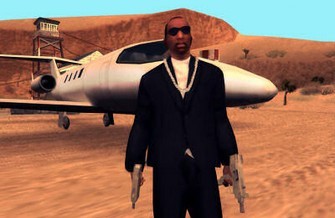 The final act revolves around Carl pulling a casino heist and returning to his hometown city with his ill-gotten gains. Along the way Carl has become a licensed pilot, won illegal street races, escaped ambushes, destroyed a drug cartel, and made permanent enemies of the mafia bosses who all get killed in GTA3.
The final act revolves around Carl pulling a casino heist and returning to his hometown city with his ill-gotten gains. Along the way Carl has become a licensed pilot, won illegal street races, escaped ambushes, destroyed a drug cartel, and made permanent enemies of the mafia bosses who all get killed in GTA3.If GTA3 was a the lightning bolt that ushered in a new kind of video game, San Andreas was the storm that followed. It gave everything that first title had, but there was simply more of it and depending on what part of the state you were in the game played differently. Honestly, it was difficult to describe how playing San Andreas in 2005 felt, but it was impossible to imagine how much better the GTA games could get.
Grand Theft Auto IV
Grand Theft Auto IV (GTA4) opens with all of the grandiosity and pomp of a large-scale Hollywood production. The music swells, the credits pop through the scenery, and we are introduced to Niko Bellic, our new main character, through a short conversation he is having with a shipmate as he disembarks from a cargo vessel into the industrial harbor of Liberty City, the same city from GTA3 but now it looks more real, more alive, more dirty.
 In this game we lose much of what made the previous iterations so much fun to play at the benefit of a huge sprawling storyline with relationships. The graphics are excellent and the physics are a marked improvement from the first few games, but hinging so much of the game on an uninteresting story about a hypocritical sociopath while simultaneously removing all of the side missions that fueled most of the exploration from previous games means that this is the least interesting game in the series. I made my own game of running over pedestrians and seeing how long I could survive with huge levels of cops chasing after me. At one point I even abandoned GTA4 for one of it's predecessors.
In this game we lose much of what made the previous iterations so much fun to play at the benefit of a huge sprawling storyline with relationships. The graphics are excellent and the physics are a marked improvement from the first few games, but hinging so much of the game on an uninteresting story about a hypocritical sociopath while simultaneously removing all of the side missions that fueled most of the exploration from previous games means that this is the least interesting game in the series. I made my own game of running over pedestrians and seeing how long I could survive with huge levels of cops chasing after me. At one point I even abandoned GTA4 for one of it's predecessors. GTA4 had two DLC packs which breathed a bit more life into the game, the most interesting of these was one focusing on a biker gang in GTA4's equivalent of New Jersey. But both of the tacked-on stories were too short and neither one brought back the missing side missions or activities from previous games.
Grand Theft Auto V
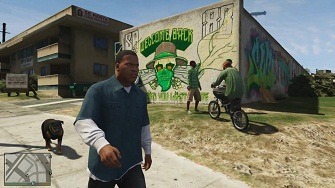 You will probably hear other people tell you that Grand Theft Auto V (GTA5) features three characters that you can play as, and the story is about how their lives intersect. And while most of the story hinges around Michael's mid-life crisis, and the character I found myself playing the most was Trevor, the main character of GTA5 is obviously Franklin Clinton, the black car thief and hustler. Franklin has the best abilities, the best car, the best home, and his story is the one that decides the fate of the other two characters.
You will probably hear other people tell you that Grand Theft Auto V (GTA5) features three characters that you can play as, and the story is about how their lives intersect. And while most of the story hinges around Michael's mid-life crisis, and the character I found myself playing the most was Trevor, the main character of GTA5 is obviously Franklin Clinton, the black car thief and hustler. Franklin has the best abilities, the best car, the best home, and his story is the one that decides the fate of the other two characters. This game features a strong story that doesn't contradict itself or try to rise above the underhanded premise of the game you are playing, and the game features the southern end of the state of San Andreas again. There is no Las Venturas or San Fierro, which is mildly disappointing as the game is still huge. There is almost too much area to explore, especially since not everything in the game takes you into every area of the game. The old and familiar side missions are still missing, instead you get tennis.


Saturday, May 24, 2014
Tyranny of Dragons
tyr·an·ny (tĭr′ə-nē) n.
1. A government in which a single ruler is vested with absolute power.
2. The office, authority, or jurisdiction of an absolute ruler.
3. Absolute power, especially when exercised unjustly or cruelly
4.
a. Use of absolute power.
b. A tyrannical act.
5. Extreme harshness or severity; rigor.
drag·on (drăg′ən) n.
1. A mythical monster traditionally represented as a gigantic reptile having a lion's claws, the tail of a serpent, wings, and a scaly skin.
2.
a. A fiercely vigilant or intractable person.
b. Something very formidable or dangerous.
3. Any of various lizards, such as the Komodo dragon or the flying lizard.
4. Archaic A large snake or serpent.
Clearly, the next D&D campaign will be focused on how an absolute and oppressively severe power enslaves any and all large reptiles.
1. A government in which a single ruler is vested with absolute power.
2. The office, authority, or jurisdiction of an absolute ruler.
3. Absolute power, especially when exercised unjustly or cruelly
4.
a. Use of absolute power.
b. A tyrannical act.
5. Extreme harshness or severity; rigor.
drag·on (drăg′ən) n.
1. A mythical monster traditionally represented as a gigantic reptile having a lion's claws, the tail of a serpent, wings, and a scaly skin.
2.
a. A fiercely vigilant or intractable person.
b. Something very formidable or dangerous.
3. Any of various lizards, such as the Komodo dragon or the flying lizard.
4. Archaic A large snake or serpent.
Clearly, the next D&D campaign will be focused on how an absolute and oppressively severe power enslaves any and all large reptiles.
Thursday, May 22, 2014
gamer ennui
I haven't really been updating this blog because I haven't been playing much lately. In all honesty, I've started to consider packing a lot of my books into boxes and storing them in a corner. I just haven't done that yet because I keep hoping my current gaming ennui will shift or change.
Whether I'm playing or GMing I want to be able to do cool shit as prescribed by the character but I also want to feel challenged by other players, or by the course of the game. I'm just not feeling it. Compound this with only having time to game a couple of nights of the week and scheduling the right mix of players together who all want to play the same thing on the same night is nightmarish.
It becomes even worse when some gamers say "Oh, I'll play anything, but not that one game you really want to play" or "Well, we're already in a game..." followed by "and there's no room for you" or "and it's on the ass-end of town from you" or "and it sucks but we're not going to stop playing" and the absolute worst is "Sure I would love to play, but I don't have time right now, I'll get back to you" promptly followed by never hearing from them ever again. My sleep schedule isn't the best, but I do have weekends off and yet the litany of schedule incompatibility seems as long as the list of gamers I know.
Maybe this is just what gaming will be like from now on but I miss having a regular group that meets for a regular game. I do have a ton of unplayed games that I own and would like to try too, but getting other people to be interested in playing a game is also a hurdle. Google Hangouts seems to be the only place to try out new games or play longterm campaigns with the same people who all consistently want to keep playing the same game.
Whether I'm playing or GMing I want to be able to do cool shit as prescribed by the character but I also want to feel challenged by other players, or by the course of the game. I'm just not feeling it. Compound this with only having time to game a couple of nights of the week and scheduling the right mix of players together who all want to play the same thing on the same night is nightmarish.
It becomes even worse when some gamers say "Oh, I'll play anything, but not that one game you really want to play" or "Well, we're already in a game..." followed by "and there's no room for you" or "and it's on the ass-end of town from you" or "and it sucks but we're not going to stop playing" and the absolute worst is "Sure I would love to play, but I don't have time right now, I'll get back to you" promptly followed by never hearing from them ever again. My sleep schedule isn't the best, but I do have weekends off and yet the litany of schedule incompatibility seems as long as the list of gamers I know.
Maybe this is just what gaming will be like from now on but I miss having a regular group that meets for a regular game. I do have a ton of unplayed games that I own and would like to try too, but getting other people to be interested in playing a game is also a hurdle. Google Hangouts seems to be the only place to try out new games or play longterm campaigns with the same people who all consistently want to keep playing the same game.
